In football, there are a variety of different tactics squads and managers can use to be successful. This variability is one of the most intriguing aspects of the sport. A specific area that is viewed in a thousand different lights all over the world is the set-up of a midfield. This is typically defined by the type of pivot, or base, it has. Once this is decided, it affects how the rest of the team shapes up.
Pep Guardiola insists on a single pivot, believing that the use of a double pivot limits his side’s attacking ability. Jose Mourinho, on the other hand, uses a double pivot as a staple in his 4-2-3-1 formation, using it for the defensive solidity it brings. Both have achieved success at the highest level using these different midfield structures.
In this tactical analysis, we will be looking at these types of midfield pivots in women’s football. We will discuss the positives and negatives each bring, and how they are used in a variety of different clubs and set-ups. The main side we will focus on in this piece is Manchester City Women. The club have normally used a single pivot with two more advanced midfielders, but in this campaign, they have switched to a double pivot in their midfield. This tactical change has brought an abundance of success along with it. In this analysis, we will look at what went wrong in City’s single pivot system, and how this switch positively affected their play.
The pivot role
Before going into the different variances of this part of the team in this analysis, we must first have a good understanding of the role of a pivot in any side. The player or players are an essential part of every team. When in possession, the pivot has the responsibility of progressing their side up the field from their initial build-up phase into the attack in the final third. Even when the midfield is bypassed when looking to attack, midfielders and specifically the pivot players are important in creating space for long passing lanes into the attacking players. However, primarily their duty is to move their sides up the pitch themselves using passing combinations or progressing forward themselves dribbling through presses.
Advantages of a single pivot
Using a single pivot in a three-player midfield, a side has one player at the base of the three with the other two occupying more advanced positions. In this structure, this position, known as the number 6, is arguably the most important in the side. They must have a great intelligence of the game and be able to see everything on the pitch to be aware of how to have their side ready to attack and defend.
There are a few main characteristics a number six must possess to be successful. In the attacking side of the team’s game, they must have a very good passing range. This allows them to look to act as the metronome for their side. This includes being able to make short combinations with teammates close to them but also have the awareness to play long, and switch play when it is necessary or possible. They must be able to evade markers. Acting as the base of the midfield, it is essential that they provide an option to their teammates whenever possible. If the pivot is marked out of a match, their side will struggle to effectively attack. The most important ability, however, is their positional sense. Being the lone holding midfielder, they must be able to effectively protect the back four when possession is lost, especially when their side are in an advanced position beforehand.
When a side has a player with these traits, it is possible to have success using this system. These come from having two players forwards in the central areas to get involved in the final phase of the attacking side of the team. Most people will associate a midfield like this with sides such as Guardiola’s whether it is Xavi and Iniesta or David Silva and Kevin de Bruyne, the Spaniard’s sides have always been know for their free number eight roles that are essential to the squad’s attacking productivity. We can see examples similar to this in the women’s game. A couple of teams that show similarities to that of Guardiola’s is Arsenal Women and Barcelona Femini.
For Joe Montemurro’s Arsenal side, their number six is Lia Walti when they play a 4-3-3 formation. The Swiss international is one of the top central pivot’s in the world and is essential in the way Arsenal play. Her passing range is top drawer, but what allows Arsenal Women to excel with her in the single pivot role is her positioning and ability to read the play. The full-backs in Montemurro’s like to get forward. This keeps the width for the side as wingers Danielle Van de Donk and Beth Mead like to move inside to find room in the half-space to link up with the numbers eights and Vivianne Miedema up top.
For Barcelona, French international Kheira Hamraoui occupies the single pivot in a 4-3-3 or 4-1-4-1 system. She excels in Barcelona’s system as she is one of the best in the world at identifying space and bypassing an opposition’s press. This allows her to be able to effectively operate in this position and keep her side constantly in possession.
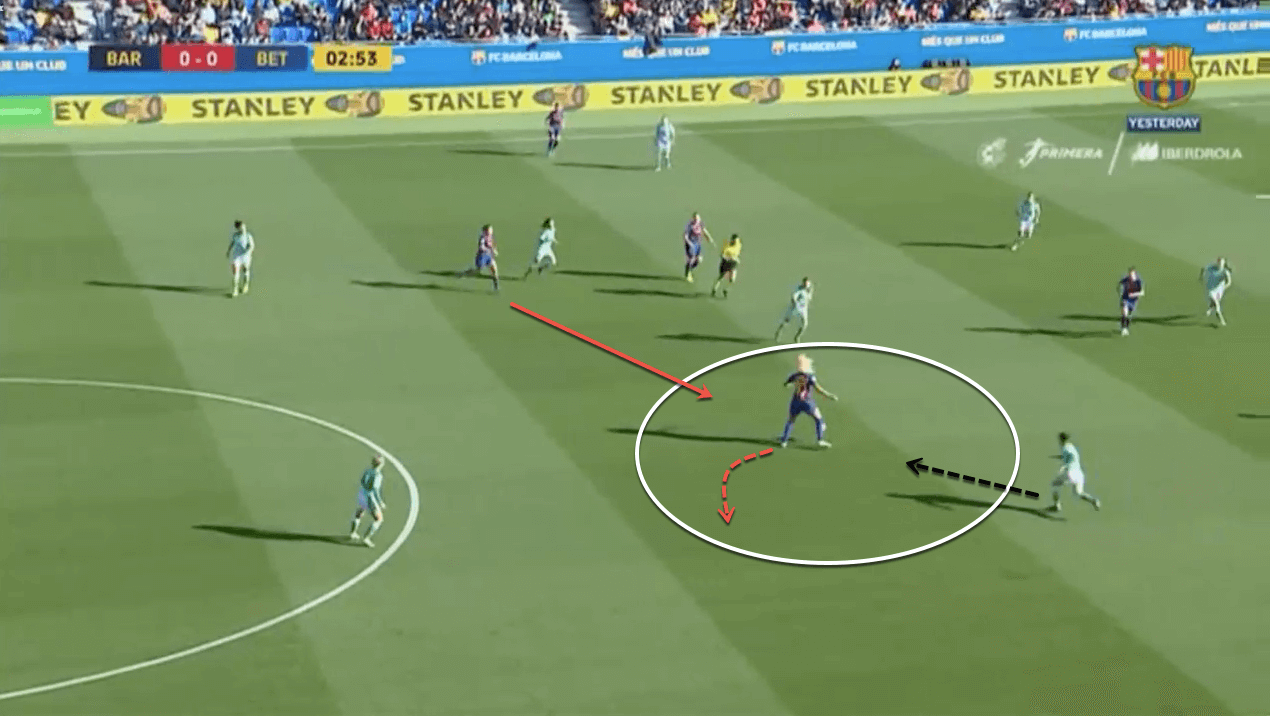
In the image above, you can see the space Hamraoui has found to occupy in between the lines of the opponent’s press. Here, she presents an option for her teammate as she looks to switch play. When the pass comes into her, she is able to anticipate the press from the defender behind her and turns away from it.
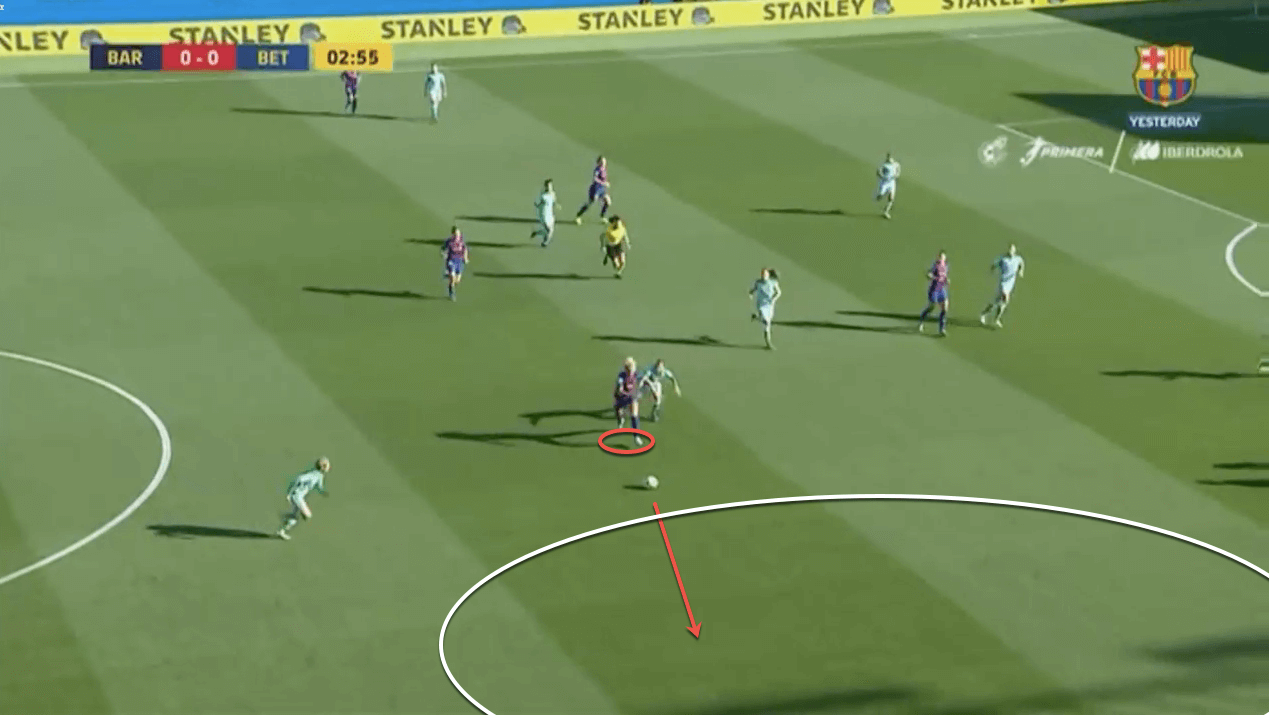
Hamraoui is then able to play a pass to the right-back to complete the switch. Having a player that is capable of playing in this single pivot role is advantageous for a variety of reasons. The ability to play two midfielders higher up the field allows the side to be more dominant in the attacking third. They are better able to take advantage of the spaces in between the lines of a defensive block, and it is much more difficult to mark the forward players.
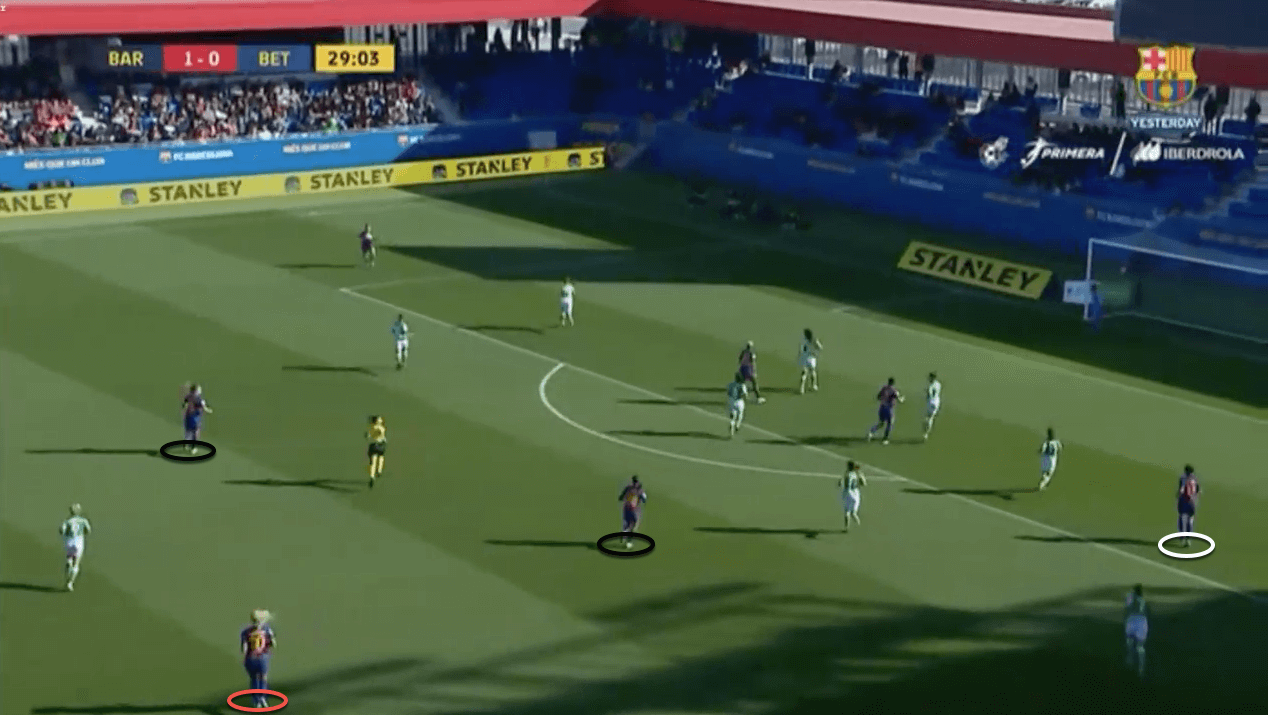
Above you can see Barcelona’s attacking structure. One of the full-backs looks to get high with the attack, creating a forward line of four at times like in this example where the right-back has pushed into the opponent’s penalty area. Behind them, the two number eights are able to roam into space they can find at the top of the box to provide attacking options to the player in possession out wide. Behind this set-up, Hamraoui looks to position herself to protect the midfield in the event of a counter-attack and occupies an area closer to the right flank to make up for the right-back’s attacking run.
Disadvantages of a single pivot
There are also various potential negatives to systems that play a single pivot. The primary issues come from a lack of defensive cover and difficulties in the initial build-up against high pressing sides.
When a team plays with an emphasis on controlling possession, it creates the need for the number six to be that much more capable at correctly positioning themselves in the event of possession being lost and the threat of a counter-attack. As we explained above with Walti’s intelligence in these situations, she is one of the best in the world at this. At other clubs, we see this exploited more often. Below you can see an example of a side in possession with a single pivot. With the other two midfielders in attacking positions, there is a huge amount of space in and around the lone number six, who is vulnerable in the event of a counter-attack.
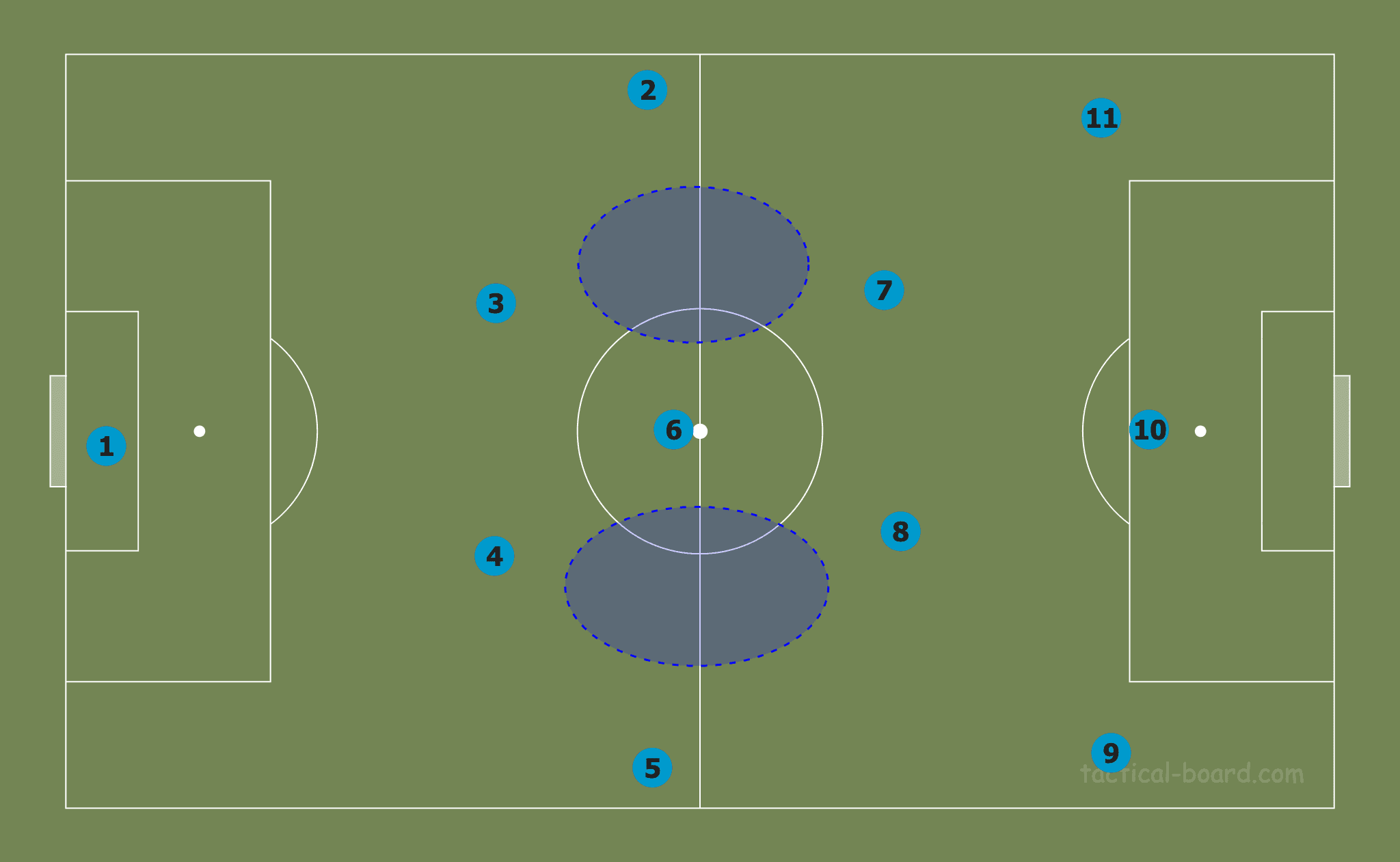
This will often lead to tactical alterations from the manager on how the side’s defensive structure is set up when in possession. These alterations will typically include using the full-backs in this counter-pressing set-up rather than having them move forward to get involved in the attack. The idea of inverted full-backs stemmed from this and aimed to provide the number six with more cover when defending. You can see one set-up with this below. The left-back has inverted in line with the number six. They have created a double pivot themselves to protect a now back-three with the addition of the right-back tucking in. Now, the side is defensively compact in the centre of the park, and if a counter-attack comes down either flank, the outside centre-halves have the support to be able to move outward to challenge players in these areas.
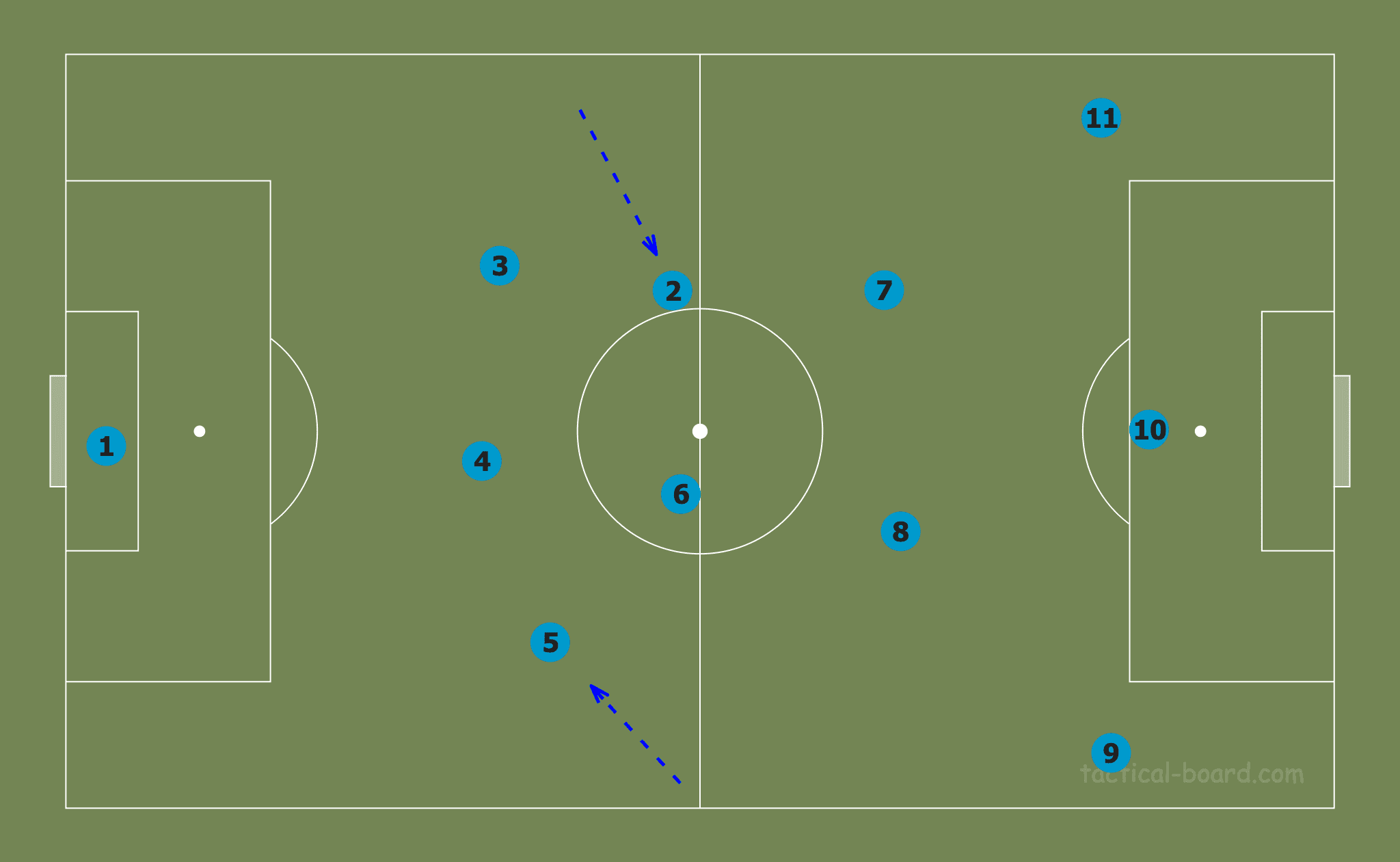
In possession, having one player in the deepest midfield line can also cause issues in terms of ball progression. When a side sends two players in the initial press or effective man-mark the number six, they are capable of effectively cutting off the central passing lanes into this number six. This forces the side in possession to look for wide outlets. Here, however, is where the majority of defending teams prefer possession to be held in because it is much easier to carry out pressing traps.
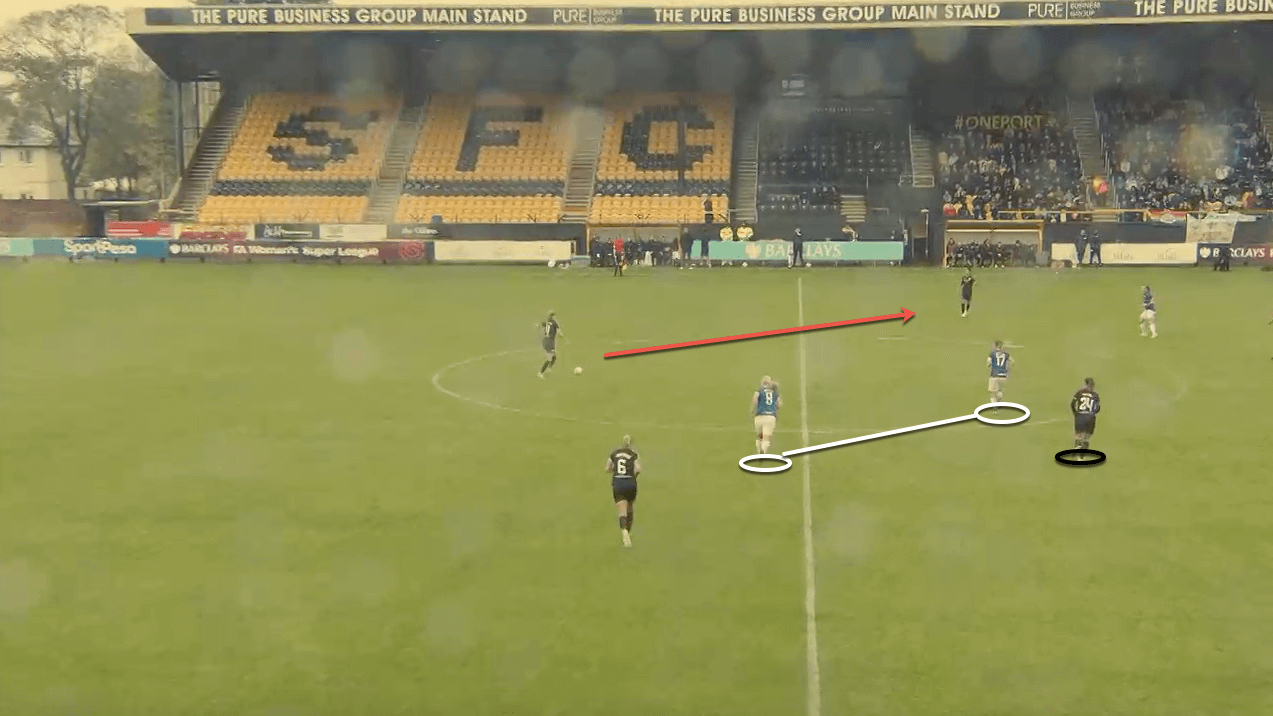
This was the main issue for Manchester City Women early on this season. In the image above, Manchester City are playing Everton Women earlier this campaign. We can see Steph Houghton in possession of the ball looking for an outlet. However, Everton’s press includes a player that man-marks Walsh in the centre of the pitch. Her positioning along with that of the striker blocks off the passing lane into the English midfielder. This forces Houghton to pass wide into Stokes.
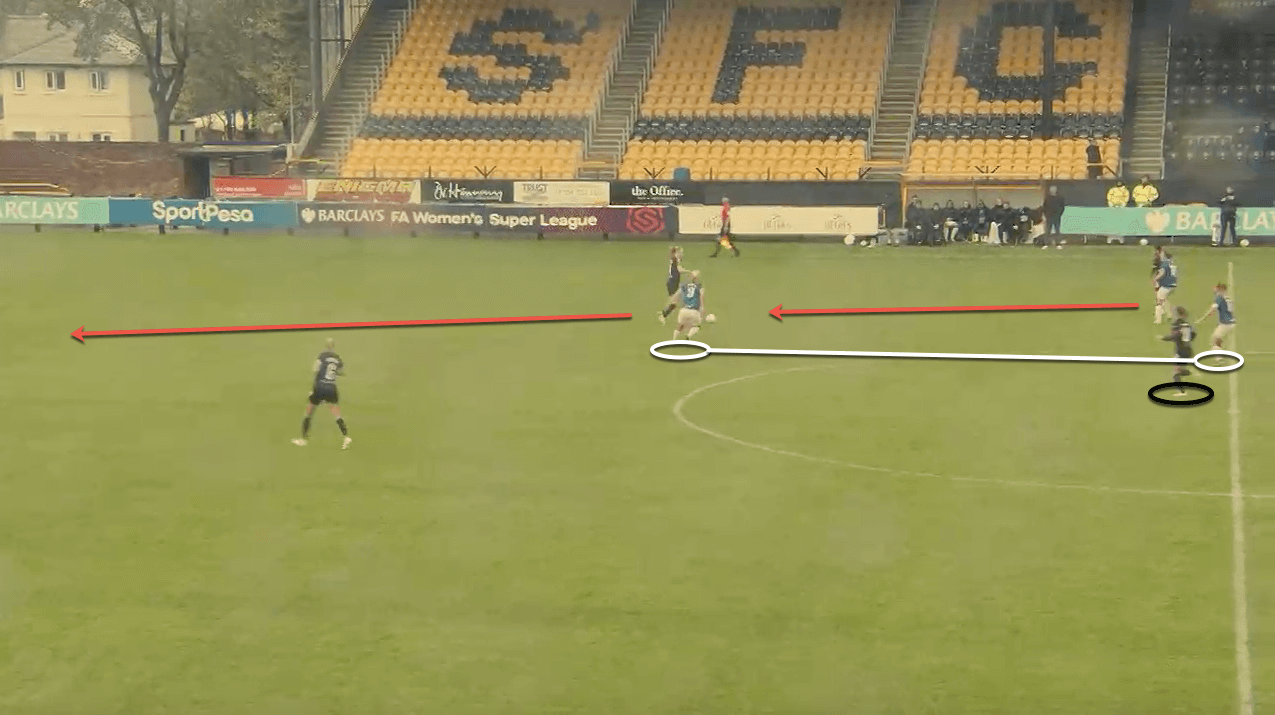
When Stokes receives possession Everton’s press blocks off any forward or lateral options, forcing her to play back to her centre-half. With this press from Everton effectively working, Houghton is forced to pass it all the way back to her Ellie Roebuck in goal to reset their structure to try and break through the press.
Advantages of a double pivot
For the reasons we discussed above, a lot of clubs look to use a double pivot in midfield. This system offers much more defensive stability. Top clubs such as Olympique Lyonnais and Chelsea Women have used this structure to great success. Since we have seen Manchester City transition to it, we have also seen them improve vastly on the form we saw early on in the campaign.
In general, the major advantages of a double pivot fall in line with the disadvantages of the single pivot. Having two midfielders holding a deep position when in possession gives greater defensive solidity to the side’s structure. It gives more protection to the centre-halves and also allows greater freedom to the full-backs. This has been a massive part of Lyon’s dominance in recent history. Lucy Bronze and Alex Greenwood are extremely dangerous going forward from the full-back positions and generate a major amount of the attacking opportunities Lyon create.
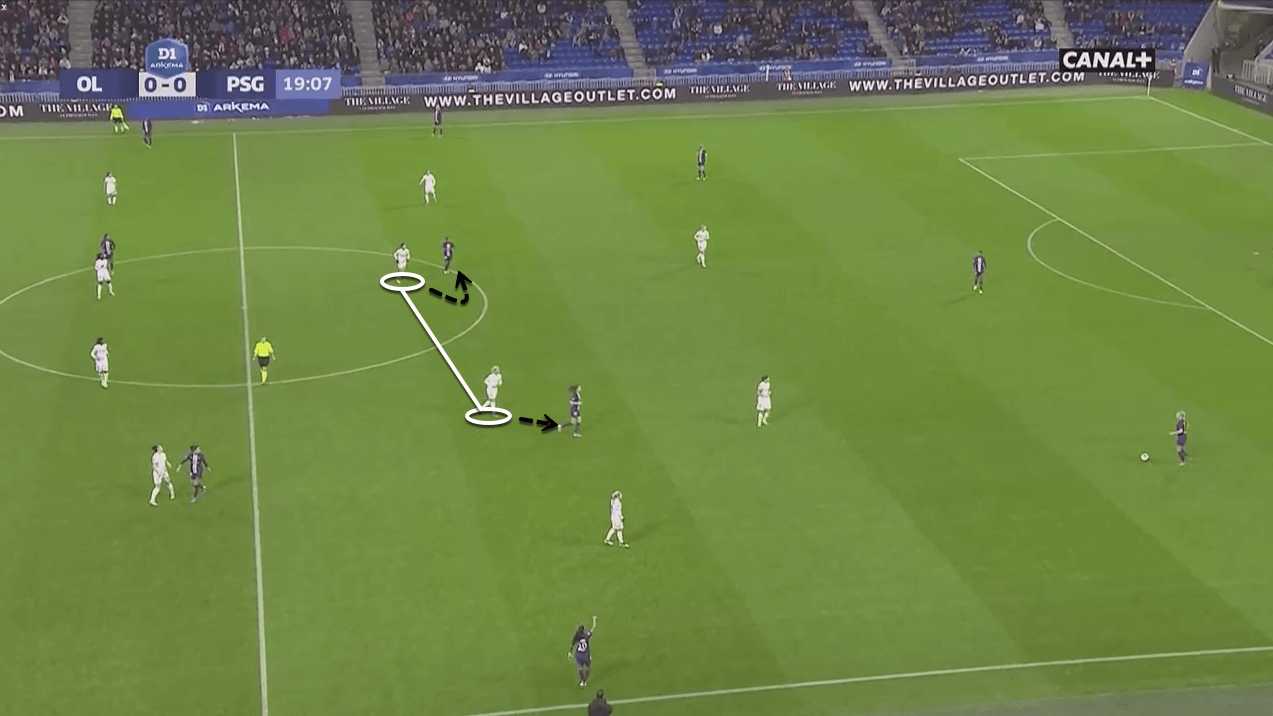
In the image above you can see Lyon defending in a 4-4-2 formation against Paris-Saint Germain. They are lining up in this structure due to PSG’s 3-4-3 system. Because the home wide only has two central midfielders, the double pivot is marking them using cover shadows. This makes it difficult for a centre-half to get a pass into these players without them being pressed into a turnover immediately. This allows the attacking midfielder to press forward in line with the striker to disturb the centre-halves in their build-up routines.
In possession, we can see the effects of this double pivot in the image below. Sitting deep in the same match against PSG, their positioning allows the full-backs the freedom to move forward. This essentially creates a 2-4-3-1 formation as the wide defenders take the responsibility of providing the width to the side, which gives the outside midfielders the ability to come inside and combine with the attacking midfielder and striker.
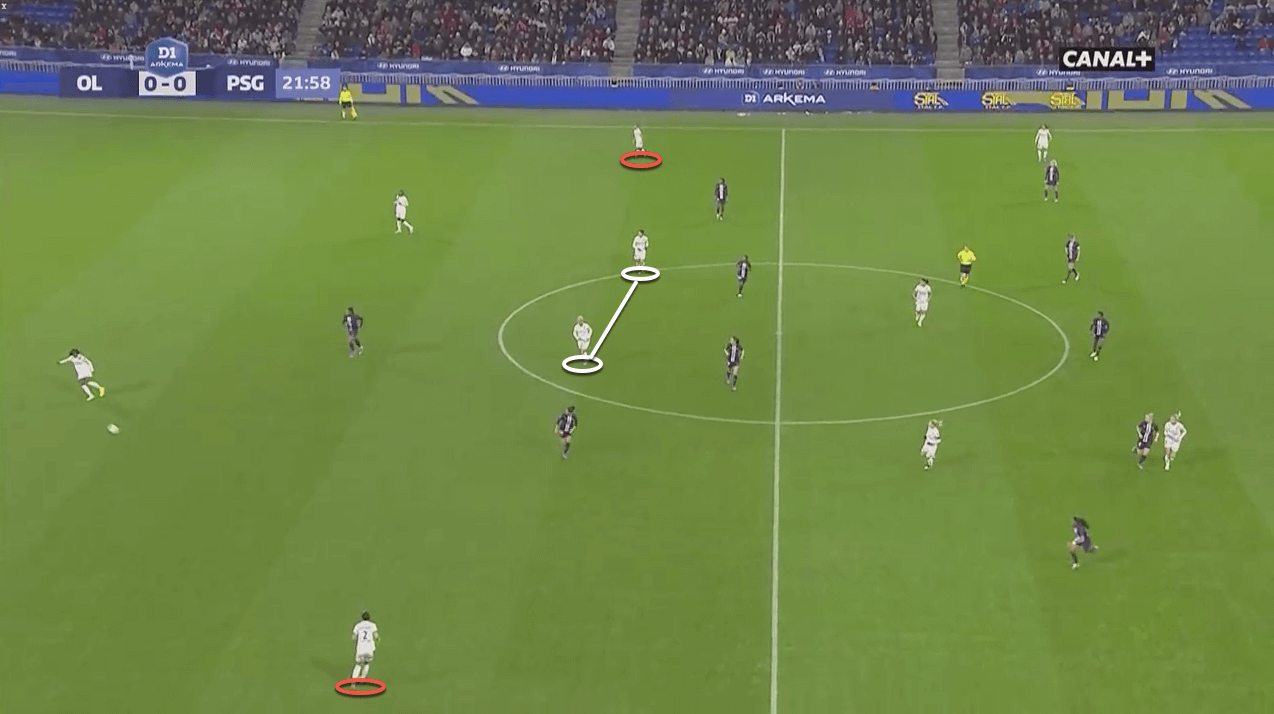
We have seen this since Manchester City’s transition as well. This switch came in line with the introduction of Janine Beckie at right-back. Since this, her attacking ability from this position has allowed City to get around the typical shortcomings of a double pivot. The Canadian attacker has essentially been given the entirety of the right flank to operate in. Jill Scott plays a wider right central midfield position than before to help combine play with the right-back and the rest of the squad, but City do not use a right-winger most matches any longer. Instead, Pauline Bremer is typically brought in to pair with Ellen White up front. On the left, Stokes plays a slightly more reserved role than she did before due to the attacking nature of Beckie, but she is still given license to move forward and is important in keeping the width for the side. This allows Lauren Hemp to come inside very close to the two strikers.
The asymmetric structure effectively removes some of the typical shortfalls of a double pivot. Hemp and Scott’s advanced inside position create a link to the strikers up top, and the two deep midfielders in Walsh and Caroline Weir each possess a great passing range to find any teammate on the pitch.
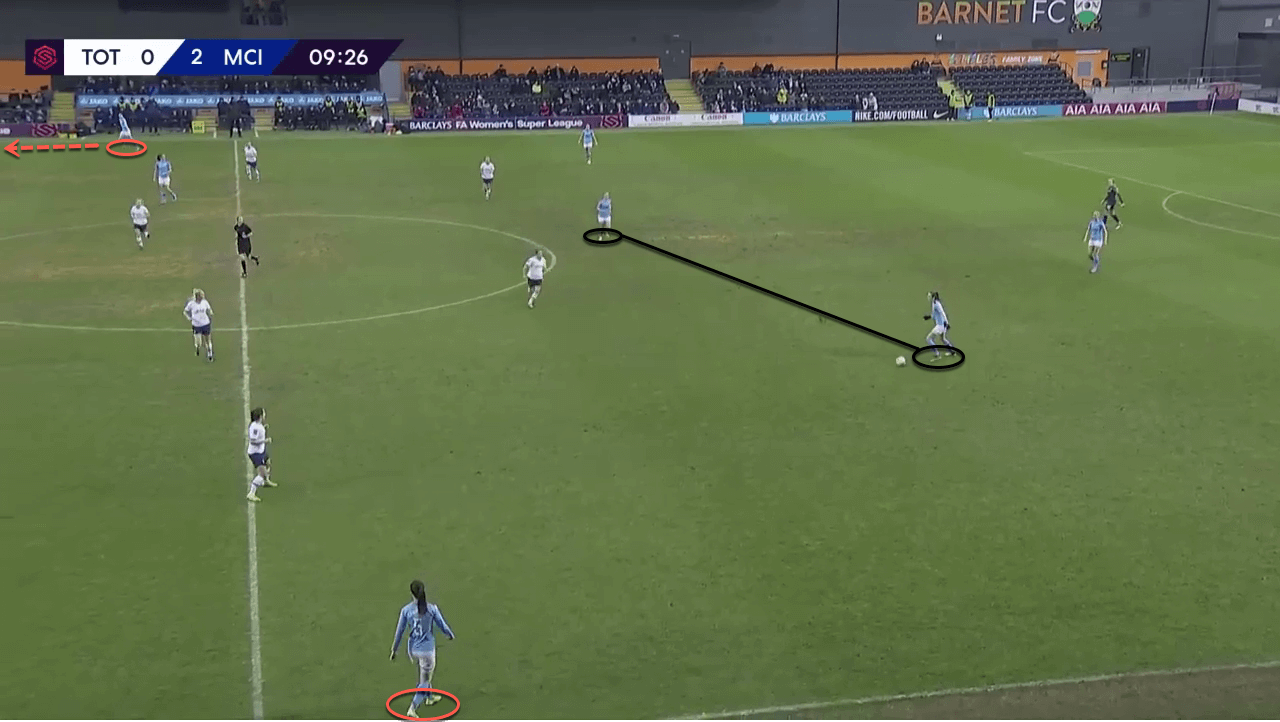
Above you can see City’s build-up shape. We can draw resemblances to the Lyon example above. However, the English side is even more attacking in their set-up, as you can see the full-backs positioning in line with Scott, who occupies the advanced midfield position. They are taking up a variety of a 2-2-3-3 system when playing from the back. With the full-backs giving the side width, it allows for the likes of Scott and Hemp to drop deeper than they normally would in central positions to provide passing options.
This system has also been successful because of the style City have implemented while using it. With the three players in White, Bremer, and Hemp, they often look to overload the opposing centre-halves and make runs in behind. Walsh and Weir are both extremely adept in playing long passes from their deep positions, and centre-halves Houghton and Gemma Bonner also possess fantastic passing ability.
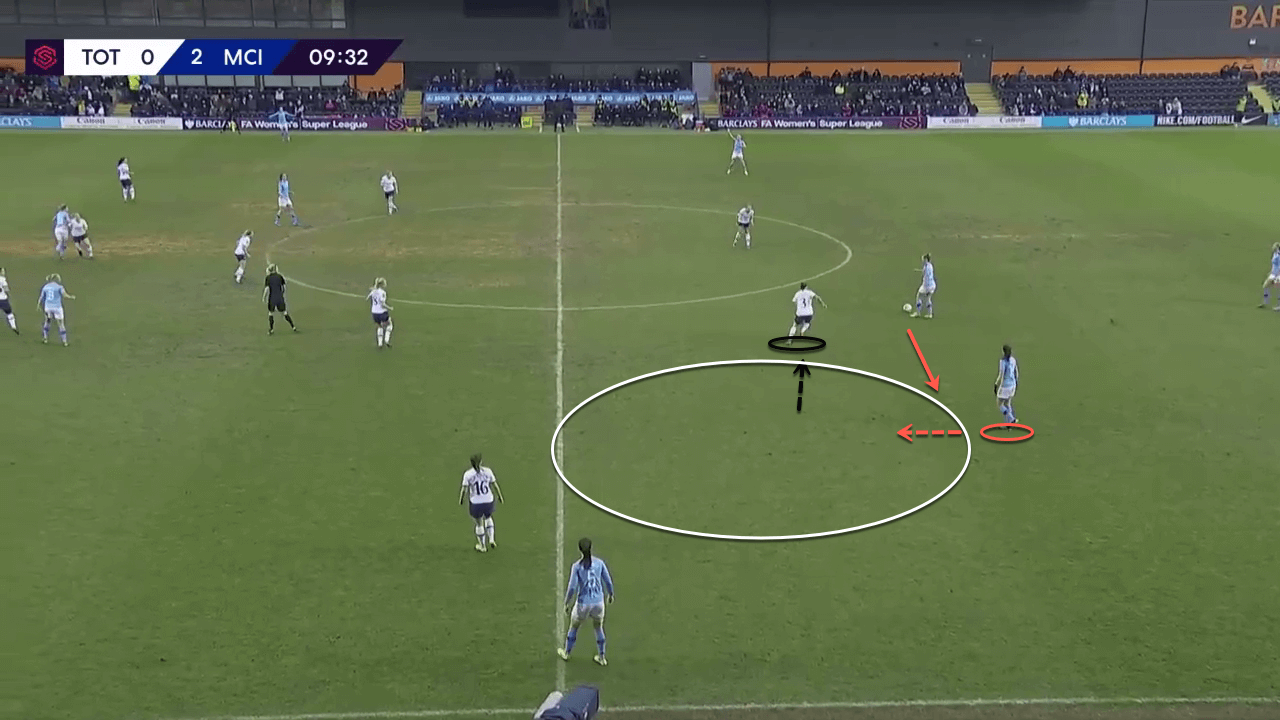
In the image above you can see City in their build-up structure once more. Here, Walsh looks to draw the Tottenham Hotspur Women press towards her while she is in possession. Once the defender commits to marking her, she plays a quick lateral pass into Weir. This pass opens up the space through the Spurs midfield.
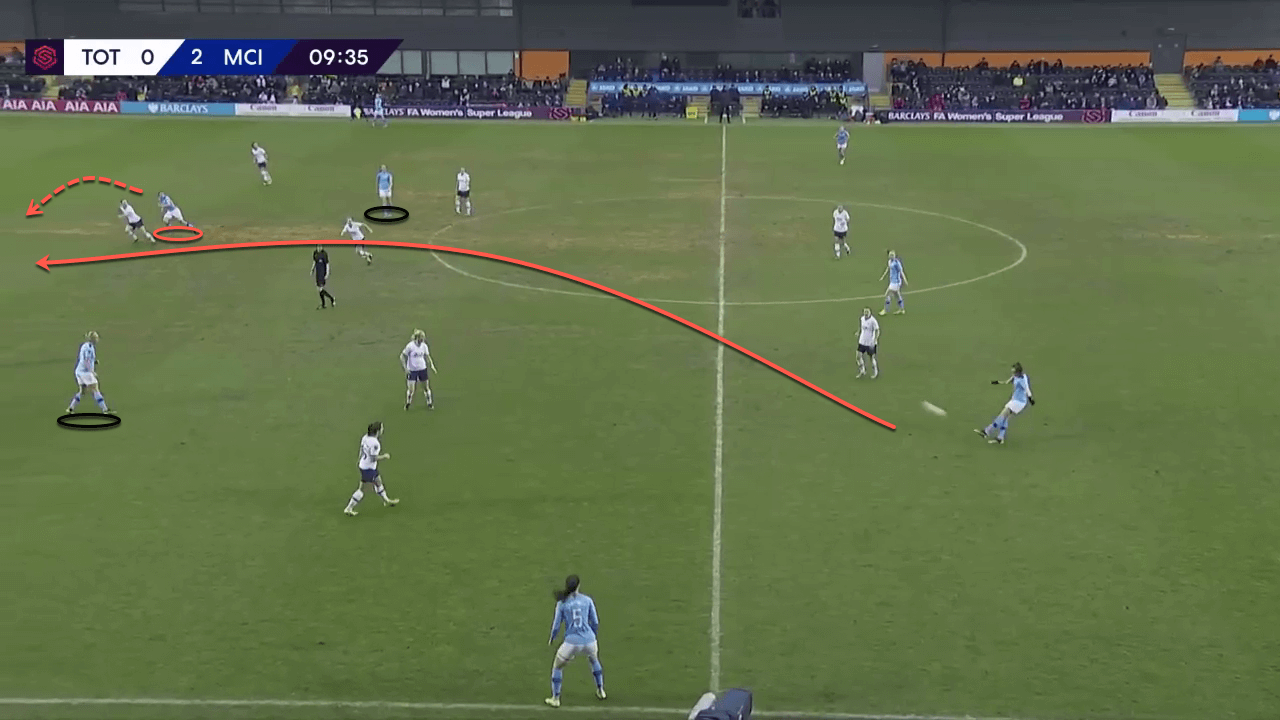
Weir then is able to pick out White who makes a run off the back shoulder of her defender into the space behind the last line. This tactic of using the double pivot to move the opponent’s defensive block has worked extremely effectively for City since their transition to the system.
Disadvantages of a double pivot
The majority of the shortcomings from the use of a double pivot come in the attacking and attacking transition side of the game. Keeping the extra midfielder deep takes away from the forward options when a side is in possession. This puts more responsibility on the number 10 to control a vast amount of space in behind the striker and between the two wingers in a 4-2-3-1, or the need for a striker to be competent at dropping in to combine with teammates in a 4-4-2.
Whereas in a single pivot structure, you have two players that occupy this space in between the deepest midfield line and the attacks. Instead, one player is given this responsibility, which can leave the side prone to becoming disconnected in the attacking phase if the opponent can effectively press them. Below you can see an example of this. The team in possession is set up in a 4-2-3-1 formation, and the opponent is lined up in a 4-4-2. In the middle of the pitch, the double pivot of the team without possession has the numerical superiority against the attacking side’s number 10. They can mark this player out of the match by closely shadowing them or cutting off passing lanes into this area. This, in turn, forces the team in possession to look to move the ball wide to get into the final third.
When possession is won back, the use of a double pivot also limits the number of outlets the defensive players have when looking to move forward. A top side we have seen this in is Manchester United Women. Casey Stoney prefers a 4-2-3-1 formation, with a double pivot of Haley Ladd and Katie Zelem. While they have shown huge promise in their first season in the top flight of English football, they still have work to do to become on the level necessary to challenge for European football and the league title.
Manchester United’s tactics are based on the foundations of defending deep and efficiently before looking to catch opponents out on the counter. However, this is where a flaw in this system appears. Most often United have all or all but one player in behind the ball against better sides. When possession is won back, this leaves the player who has won it back with little options when it comes to an outlet pass. This typically forces the player to look for an audacious pass which could be dangerous in giving the opponent possession in an advanced area or kicking it long in hops for the number nine to win it and hold up play.
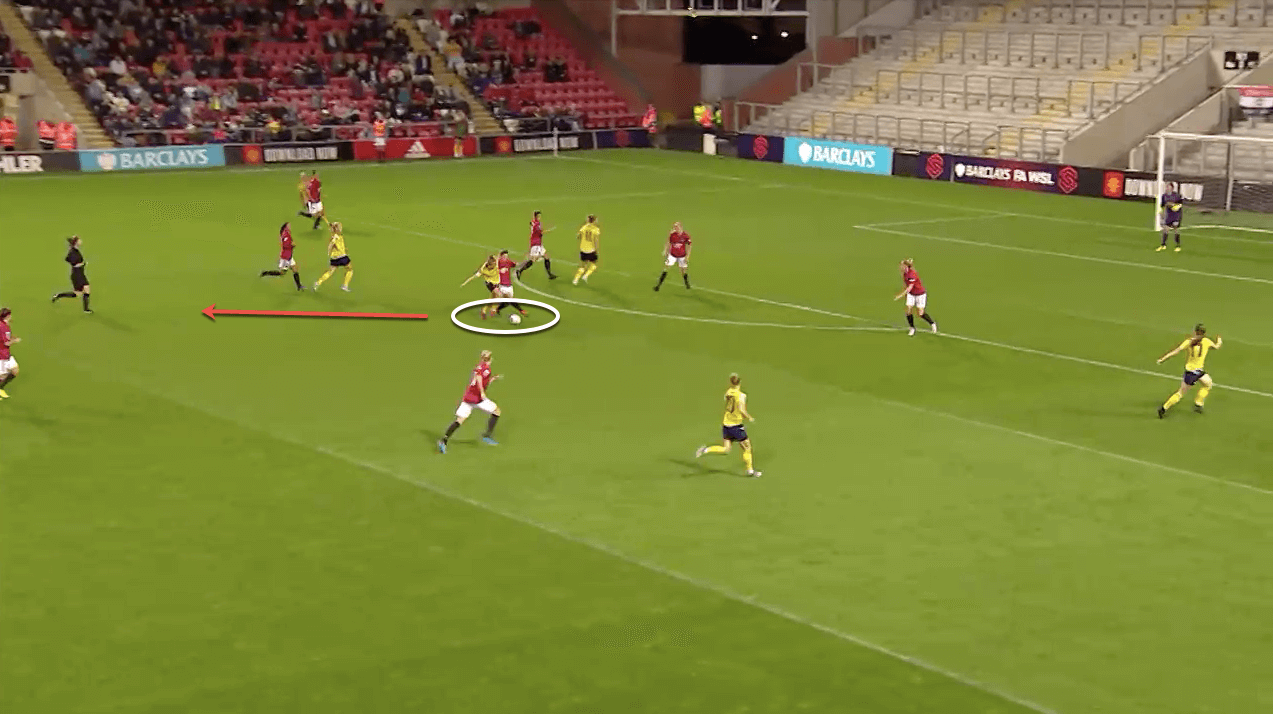
In the image above Abbie McManus makes a tackle on an Arsenal attacker. Once she wins possession she plays a short pass in Ladd, who turns and looks for support. However, as you can see, United have tons of numbers in defensive areas.
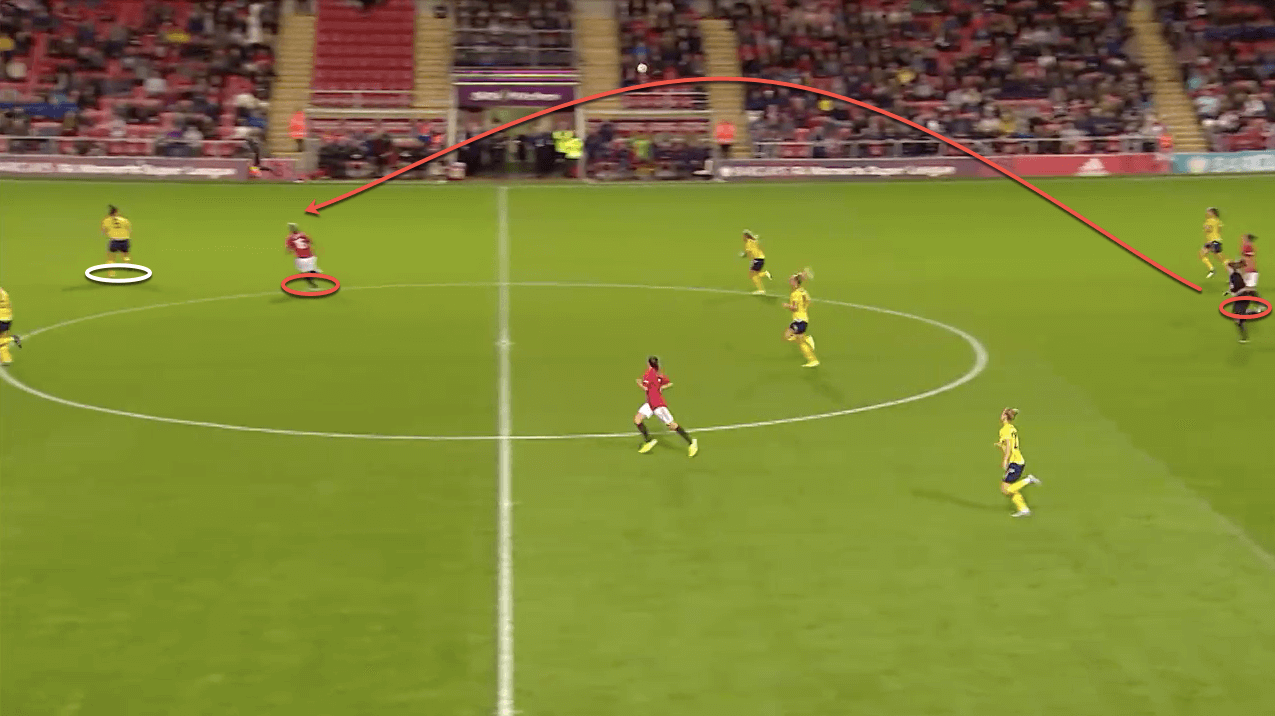
She opts to try and play a long pass into the channel for Lauren James to chase. The forward is unable to reach the pass though, and possession is quickly returned to the visiting side.
Because of this, Manchester United Women have had to look to alternative methods of playing out after winning possession. One way that has brought success is through their captain. Zelem is extremely skilled in dribbling out of presses, and driving her side forward when she gets control of the ball. On numerous occasions, you will see her driving United forward in attacks that lead to a chance or goal. However, just like the example above, the use of a deep double pivot can lead to a lack of outlets higher up the pitch. When this is the case, possession is more often easily turned over, and the side is forced to defend deep again because they cannot hold possession long enough to move out of this defensive shape.
Hybrids
In some instances, we see sides that use a hybrid of the two systems. The most notable one of these is in Germany, where Wolfsburg have dominated using this for years. They shift their midfield pivot depending on when and where they have possession.
Out of possession, Wolfsburg set up in a 4-2-3-1 formation, or 4-4-2 depending on how they need their initial press to look. Regardless, a staple in their side is the double pivot that sits in front of the defensive line and looks to break up attacks before they can become truly threatening. Their usual pairing in this place is Sara Gunnarsdottir and Alexandra Popp. Both are defensively adept to hold these deep positions. Against Bayern Munich in the league campaign, the defensive work of these two was essential as Wolfsburg’s opponents looked to control possession and break down their side.
In possession is where this system looks to change. When playing out from the back, the two midfielders remain deep to provide options for the centre-halves and goalkeeper. However, when possession is advanced forward, Wolfsburg switch into a single pivot, with Gunnarsdottir taking the role. She sits directly in front of the defensive structure and orchestrates play from here. Ahead of her, Popp goes to the other extreme and takes the role of a secondary striker. She joins Pernille Harder in playing on either side of the main striker and working in pockets of space in between the lines and inside the half-spaces. You can see this shape in the image below.
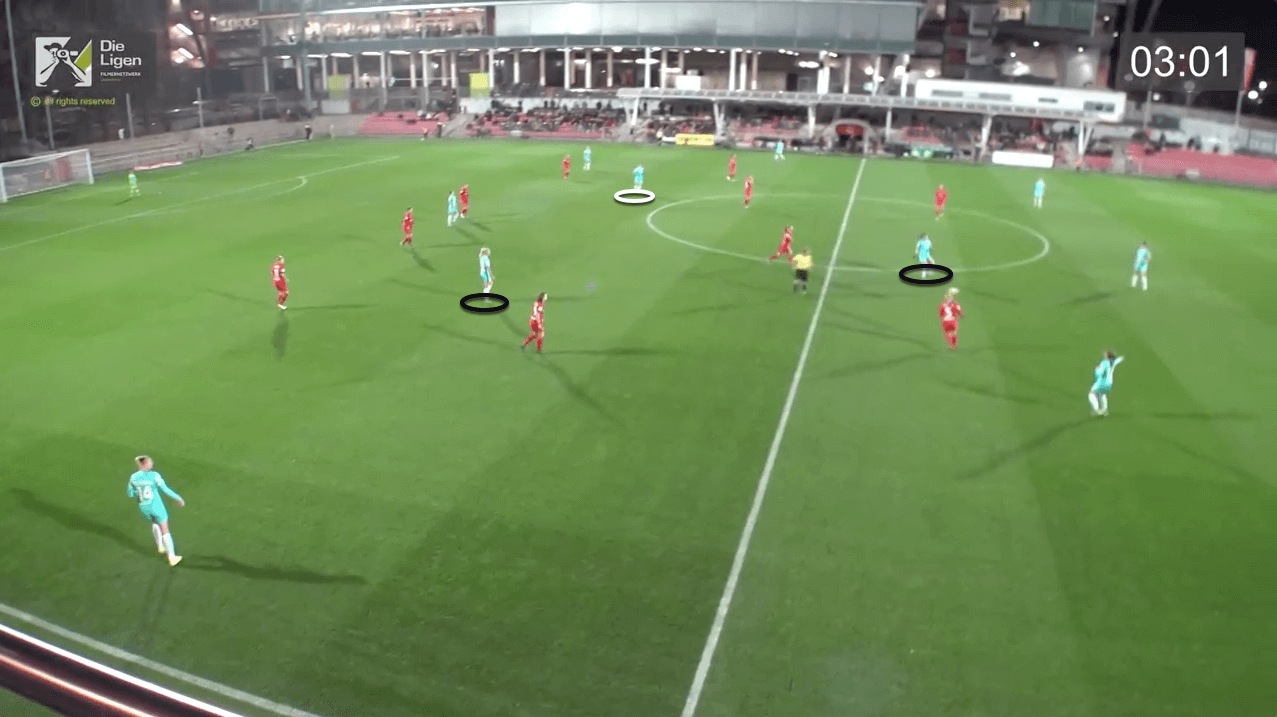
As you can see, Gunnarsdottir is left to operate the midfield almost completely on her own. Wolfsburg then opt to overload the opponent’s defensive line and look to progress through their attacking patterns using this tactic.
Conclusion
As we have discussed in this analysis, each type of pivot has its benefits. Both offer stylistic abilities that the other doesn’t, and for this reason, we will continue to see the two of them being frequently used throughout Europe. While we mentioned that some systems show similarities to traditional set-ups we have seen before, systems like Manchester City Women’s new double pivot or Wolfsburg’s hybrid pivot show the tactical evolution we are seeing in the women’s game. This will continue to grow, but the basic foundations of the midfield structure will always remain the same.





Comments